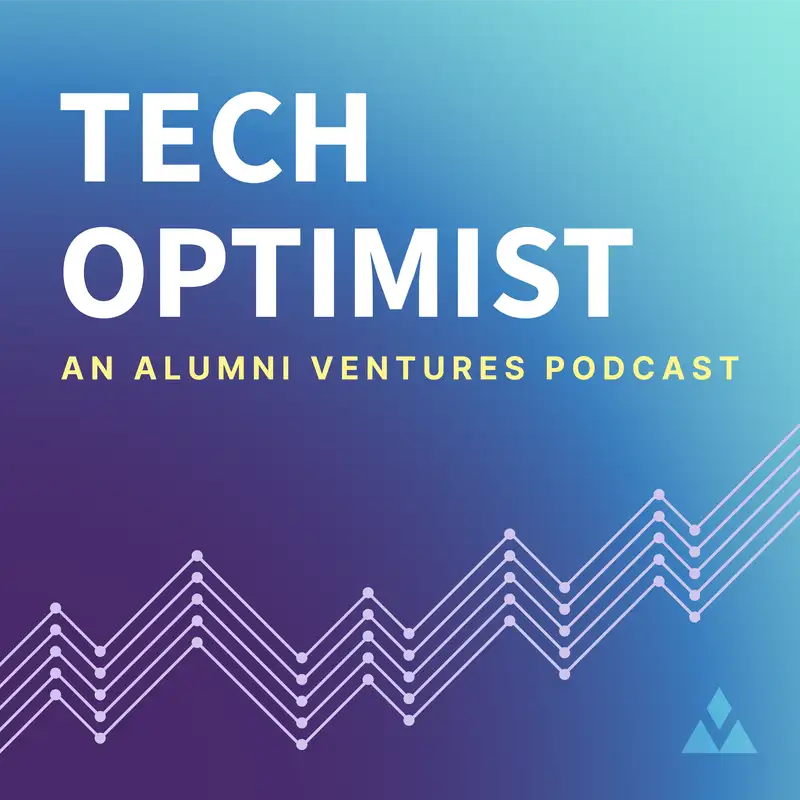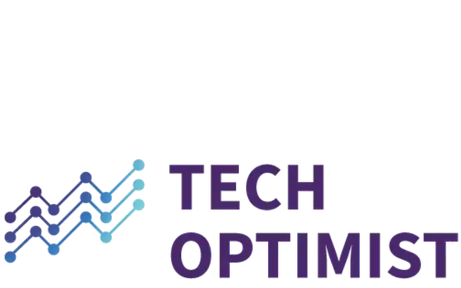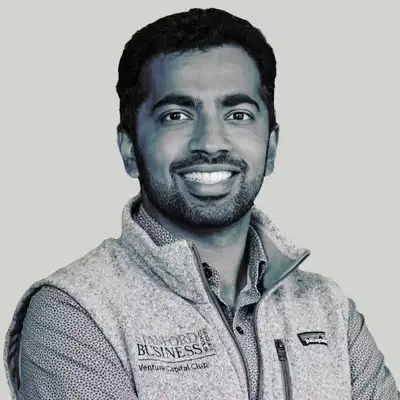#66 - Three Breakthroughs: Digitizing Smell Using AI
Samantha Herrick:
Welcome to the Tech Optimist. This is a podcast brought to you by Alumni Ventures, a show where we tell you the stories of tomorrow.
Mike Collins:
As these technologies which are so exciting and so profound in areas of robotics and AI, these have societal implications.
Samantha Herrick:
That is Mike Collins, co-founder and CEO of Alumni Ventures.
Naren Ramaswamy:
The applications that this can have are numerous. It's giving a machine a new sense.
Samantha Herrick:
That is Naren Ramaswamy, Senior Principal at Alumni Ventures. And that's me. My name is Sam, and I am the tech note writer, editor, and just overall lover of the show.
Hello everyone. Welcome back to a Three Breakthroughs episode of the Tech Optimist. You met our guests, you met me. You know the speakers of this episode. Now we're going to do something a bit different today. I don't want to tell you the topics today. I want you to be surprised about the topics. But I can definitely tell you some hints onto the breakthroughs that Naren and Mike are going to get into today. We're going to get into robots, we're going to get into bugs, and we're going to get into boats. So I'll leave that up to you. Those are your hints. But yeah, I'll stop yapping and we'll hop right into the episode. And please enjoy the show.
As a reminder, the Tech Optimist podcast is for the informational purposes only. It is not personalized advice and it is not an offer to buy or sell securities. For additional important details, please see the text description accompanying this episode.
Mike Collins:
Welcome to the Tech Optimist podcast. This is our Three Breakthroughs show. I'm here with Naren Ramaswamy. Welcome Naren.
Naren Ramaswamy:
Hi, Mike. Excited to do this.
Mike Collins:
Yeah, so this is a show where we tried to pull together three things that caught our eye, that we think have profound implications for technology, venture capital eventually, entrepreneurship, innovation. And this one, the first one sounds a little odd, which is the mapping of fruit fly brain. Probably can't say that three times. Lucky to say it once correctly. But this was a big project actually, that there were something like 75 labs involved, 300 researchers,
Samantha Herrick:
Okay, so this breakthrough is so fascinating to me and to all of the AV team. So I have actually found an article from the Smithsonian Magazine titled Scientists Unveil the First-Ever Complete Map of an Adult Fruit Fly's Brain Captured in Stunning Detail. Now we're going to throw up a visual or a video of this mapping of this digital, colorful, beautiful map of this fruit fly's brain just along while I'm reading a few parts of this article. So this article is written by Margharita Bassi. She's a daily correspondent for Smithsonian Magazine, and it came out October 4th of this year.
So I'm going to read a few sections of it because I think it gives a little bit more context to what's going on. And it's a really good segue way into Naren's breakthrough with AI and machines that can smell. They used artificial intelligence to reconstruct the fly's brain cells based on the image data. But the model wasn't perfect and it made some mistakes. So the researchers created the Flywire Consortium to recruit hundreds of volunteers to proofread and annotate the 3D brain called a, okay, I might butcher this, called a connectome by hand.
At the end of this monumental collective effort, the team had produced the most complete brain map of any organism to date. It totaled nearly 140,000 neurons, 8,453 different types of neurons, and more than 54.5 million synapses. The team's understanding were published in a series of nine papers in the Journal of Nature. Unraveled end-to-end, the fruit flies brain neural wiring could stretch out to more than 490 feet, which is longer than four blue whales aligned nose to tail. This is per Carl Zimmer, a reporter from the New York Times. So then a little bit more into how this can help us down the road. The connectome and all the data associated with it reveals patterns of healthy brain function that can thus also be consequential in the treatment of brain diseases.
Of the 8,453 types of neurons, the scientists identified 4,581 that were newly discovered. So the brain map also provides insights into the neurotransmitters such as dopamine and serotonin secreted by the various types of neurons. Anita Devineni, a fruit fly expert at Emory University who was not involved in this study, tells the New York Times that she relies on the team's publicly available data to plan new experiments. So they're using this for everything that they do now. Scientists hope to eventually map the brain of a male fruit fly to complement this female brain, then move on to even more ambitious projects such as creating a connectome for the mouse brain, which has more than 1000 times as many neurons as a fruit fly. That's pretty bonkers.
Mike Collins:
Obviously, fruit flies are a basis of a lot of research in a lot of different ways. There's lots of reasons scientists pick fruit flies. But the work being done to really map out, in detail, their brains, I think just points the way of mapping the human brain. And when we can do human brains, there's really exciting stuff that has potential with disease. I think there's issues with brain-computer interfaces. I think there's even longevity aspects where you could upload, download your brain is maybe even in our lifetime kind of thing.
So I think there's very exciting things that this points to. Obviously in the short term, a lot of these innovations turn into people that have either disease or some acute brain injury where the cost benefits are just so profound of tinkering, that it becomes exciting. But again, I think this is a huge breakthrough. I think it is noteworthy. I think it is not talked about, but the understanding of the human brain is one area that I think we're making great progress with.
Naren Ramaswamy:
Absolutely.
Mike Collins:
And I'm not going into a lot of what does this mean exactly? People can read about it. We'll put some show notes in where people can read the more extensive things. But from a breakthrough, I think it's a big one. Any thoughts on that Naren?
Naren Ramaswamy:
It's amazing that I'm thinking about biology as a subject is the study of the human body. And the tools that are now available to be a biologist, at the cutting edge, are just more ubiquitous than they've ever been. And it's an exciting time to be a scientist. This is just biology. And we're going to talk about a couple other breakthroughs here. It goes back to what we've been talking about in the past episodes, the pace of innovation is increasing. And the multidisciplinary implications of this are also very interesting because if you look at neural networks that govern the field of AI today, they were built, the architecture was built based on what we understood of the brain. And now we have even better understanding of the brain because of AI, and that's going to be a virtuous cycle. So it's fascinating.
Mike Collins:
And then seeing again, some Nobel Prize, it's Nobel Prize season, and seeing where the Nobel Prizes are going now. And I think we'll talk more about it in future episodes. But a couple of the winners were working in the area of biochemistry with the AlphaFold and understanding proteins and protein folding. And again, not my area of expertise, but it is clearly the depth of understanding of how the human body works using AI, using tools, creating these feedback loops, and the ability to create small molecules with these tools like AlphaFold and AlphaFold spin outs and startups, which are some of the most exciting investment areas, I think in the life sciences where we're really going to turn medical discovery from bespoke trial-and-error and looking to the natural world.
Some spit from some reptile produces some unpredictable result in the lab, to really going and targeting what do we want to solve? What do we want to have happen? What kind of molecule protein do we need to make XYZ happen? And when it becomes an engineering problem, we see geometrically better results and speed and efficacy and reduced side effects. And so again, a couple of very related things there.
Naren Ramaswamy:
Yeah, that's a great point about the discovery process becoming more engineering centric rather than just serendipity. It's fascinating and it's a good segue way into the breakthrough that I wanted to talk about.
Samantha Herrick:
Don't go anywhere. We got a commercial break and then we'll be right back.
Speaker 5:
Exceptional value creation comes from solving hard things. Alumni Ventures Deep Tech Fund is a portfolio of 20 to 30 ventures run by exceptional teams who are tackling huge opportunities in AI, space, energy, transportation, cybersecurity, and more. These game-changing ventures have strong lead venture investors and practical approaches to creating shareholder value. If you are interested in investing in the future of deep tech, visit av.vc/deeptech to learn more.
Naren Ramaswamy:
We've talked about AI that can read the internet. It can see images, give you insights. It can hear, you can talk to the AI and hear it speak. But the one sense maybe that it hasn't touched yet is the sense of smell and aromas. Scientists are working on that as well. And then so I'd love to touch on that a little bit because researchers are now able to predict the characteristics of certain smells and even create new scents. And in particular, the pioneering company in this space is called Osmo. And we're not an investor, at least yet, in this company, but it's a really, really cool tech. So I thought it was worth highlighting.
Samantha Herrick:
Okay, so in regards to this breakthrough that Naren shared with us, the Toyota researchers do, about a year ago, put out a really awesome video of all of the new breakthroughs they have made with their robots. So the video is called Teaching Robots New Behaviors. And these new behaviors are crazy things. They're mostly new dextrous behaviors from demonstration, once the robot is taught from a human what to do. But just watching this video and hearing from the researchers behind it and then also pairing that in with Naren's breakthrough, it's insane to think what scientists and engineers and just contractors can build.
Especially if AI is brought into this and we're really trying to exemplify biology and the human brain, and especially with the fruit fly brain mapping from earlier as well. If the mechanical side catches up with the AI side, we are in for some crazy breakthroughs. So here's that video from Toyota and then we'll get right into the interview after this. So enjoy.
Russ Tedrake:
Here at TRI, we believe robots should amplify people at home and at work. To achieve this, we conduct cutting-edge research to make robots more flexible, robust, and general purpose. We've had a bit of a breakthrough. Today, TRI is announcing a new method to teach robots dextrous skills quickly and easily. Our approach is built on a powerful generative AI technique called diffusion policy. This allows us to teach robots much faster and with significantly fewer demonstrations. The approach holds great promise for creating what we call large behavior models. Just like large language models have revolutionized chatbots, these behavior models will allow robots to perform useful work in ways never possible before.
Ben Burchfiel:
Up until now, the majority of robotic manipulation work has focused on pick-and-play style tasks where a robot is limited to relatively simple sets of objects it's rearranging. Our new approach goes significantly beyond that and lets us explore much closer to the limits of the hardware. TRI's robots are now capable of using tools, pouring liquids, and peeling vegetables. It's exciting to see them engaging with their environments in rich, multifaceted ways and all achieved without changing any code or explicitly programming any new skills. Using this technique, we've taught over 60 diverse behaviors to our fleet of robots. The process starts with a teacher demonstrating a small set of skills through teleoperation. Then our AI-based diffusion policy learns in the background over a matter of hours.
It's common for us to teach a robot in the afternoon, let it learn overnight, and then come in the next morning to a working new behavior. To make this level of dexterity possible, every part of the robot platform must be solid, from the hardware all the way up through the entire software stack. One key enabler is providing human teachers with a sense of touch or a haptic teleop device. Also, just like people, we found that robots learn better when they have a sense of touch. And a perfect example of this is the task of flipping a pancake, where the robot has to make contact with the surface it can't see. Without a sense of touch, it struggles and performs poorly. But its successful in learning the skill once it's able to feel its interaction with the environment.
Russ Tedrake:
This is only the beginning. Our team is deeply focused on achieving large behavior models that I mentioned earlier. We anticipate the next breakthrough will be when we train the robots with enough dexterous skills that they're able to generalize, performing a new skill that they've never been taught. To realize this, we're building a diverse curriculum for robot learning, essentially a kindergarten for robots to teach them numerous foundational skills that are useful for working alongside people.
We're on-pace to teach 100s of new behaviors by the end of the year and over 1000 by the end of 2024. We're also leveraging our expertise in simulation to augment our real-world teaching. And finally, we're developing fundamental tools for fleet learning so that when one robot learns, they all learn. I've been working in robotics research for a long time now. The tasks that I'm watching these robots perform are simply amazing. Even a year ago, I would not have predicted we were this close to this level of dexterity. And the rate at which we're able to teach new skills is simply astounding. Nearly every day I wake up to a new message showing the robot doing something it couldn't do the day before. This is an incredible time to be a roboticist.
Naren Ramaswamy:
The applications that this can have are numerous. It's giving a machine a new sense. And this could be, We've long talked about how dogs can detect cancer because their sense of smell is 10,000 times better than a human sense of smell. So imagine if an AI that's just around you can monitor your health in that way. And we use insect repellents and other sorts of deodorants and a number of different sprays, and we actually don't really know the impact to the human body. But now, what if we could engineer a healthy, sustainable scent? And so this is far-reaching across many different disciplines. And it's pivotal, especially because certain scents have similar molecular structures, but they might actually smell very different. And so really understanding that and building a foundation model to predict what a scent looks like and what the characteristics are, I think is fascinating.
Mike Collins:
And it's just interesting too, which is human sight is very evolved and we get a lot of data. Again, if we view all of these things as sensors going into our biological computer, the amount of data we're getting in via sight, literally our eyes are like a sensor that's pretty hardwired directly into the brain. And our sense of smell is underdeveloped, frankly, again, compared to other animals like dogs. So we don't even know what we're missing, frankly, as human beings.
And these things have evolved over time, but there is as much data with smell in existence, if you will. All of these different sound, touch, smell, vision, these are all, in essence, available to be sensed and then put into the brain. So seeing innovation among all the senses and then having this mirror computational silicone brain, which still it needs sensors and input and data for it to process well. So again, I just think it's the mapping and the models here are really interesting. Again, I think the smell area is one that's so fascinating because we just get glimpses with the dogs detecting cancer and things like that. I just think there's a whole spectrum of going on here that we have no understanding of at all, because our system is so underdeveloped compared to some of our other senses.
Naren Ramaswamy:
And it didn't need to develop because you look at human history, vision became the primary sense that we relied on. And again, it's something that the discovery or development of these different senses was left to chance again. And now again, it's becoming an engineering problem, which has some interesting implications.
Samantha Herrick:
Okay, we got a second for a sponsor spotlight, and then we'll be right back. Hang tight.
Speaker 5:
Do you have a venture capital portfolio of cutting-edge startups? Without one, you could be missing out on enormous value creation and a more diversified personal portfolio. Alumni Ventures, ranked a top-twenty VC firm by CB Insights, is the leading VC firm for individual investors. Believe in investing in innovation? Visit av.vc/foundation to get started.
Mike Collins:
All right, and then the third one I think we have today is really what's been going on with a couple of unions. There was a Hollywood strike and the longshoremen strike.
Samantha Herrick:
The longshoremen strike is a significant labor action that began on October 1st of this year involving dock workers at major ports along the east and Gulf coasts of the United States. The overview of the strike. Approximately 45,000 to 50,000 dock workers represented by the International Longshoremen's Association, or the ILA, walked off the job. This is the first major East coast dock strike since 1977. The strike affects 36 ports from Maine to Texas, which collectively handle about half of the US imports and exports. So you're probably asking yourself, "Well, why did they strike in the first place?" So the main issue was compensation. The unions seek substantial wage increase over a new six-year contract. The technology and job security also was not up-to-par, so there were concerns about automation threatening their jobs and just the foreign interest imports.
How this impacted the business and economy. So this disrupted supply chains and it led to, it could potentially lead to shortages and price increases. There are major impacts on industries like manufacturing, construction, retail, eCommerce. There's possible inflation, concerns about the holiday season, product availability and pricing. And as of October 3rd, the dock workers strike was suspended. There's a tentative agreement which includes a 62% pay raise over six years, says ABC News. But from there, we don't know much else. We assume that it has been suspended and will be indefinitely, but you never know. Sometimes these things take a lot of time to resolve. So we wanted to give you a little bit more information on that so that when we get into the rest of Mike and Naren's conversation, we got a bit more context and understanding behind their conversation right here.
Mike Collins:
What I found interesting and why this is on the show this week is really. In both cases, part of the negotiations were salaries and, what I'll call, fairly typical stuff. But really identification of automation and technology and it being a dimension that unions want to negotiate on. And again, I'm not going to get into the specifics of the negotiation. One, I'm glad to see that they're working, they're happy, that that's solved. It is clearly a choke point for the economy.
So it's nice to see that that has been, at least, temporarily resolved. But I think the point for our show is that this is something that I think we all need to anticipate, which is, as these technologies which are so exciting and so profound in areas of robotics and AI, these have societal implications. And there are second- and third-order implications. And they're feeling it. The longshoremen are concerned about robots and AI taking their jobs. It is a very difficult, but I think to be anticipated situation. Let's just take these two particular areas of innovation. I think if you look back through history, and I think it's an important guide, which is whenever we have these big breakthroughs, we have secondary, I sometimes call them shadow trends that follow in place.
You and I are working on a piece right now that is about a shadow trend, which is the bespoke economy, which is the theory that we believe as these technologies automate work and life, that human beings will crave bespoke, high touch, story-laden experiences, products, and services. And we'll touch more about that.
Naren Ramaswamy:
Personalized stuff.
Mike Collins:
Personalized stuff that really has a human dimension in it. So the shadow trend of any food, customized for me, delivered instantly, which is, I'm going to want to go to a farmer's market. That that's the counter trend or shadow trend that we're going to see. But I think what we're seeing in this Longshoremen and the Hollywood strike is a third thing, which is the backlash trend. Which is when change happens that there is going to be a very predictable backlash.
And we saw this with the release of ChatGPT where school their backlash was, whoa, outlawed at our school. Because that was their immediate response. And you can go back all the way, Luddites, all the way through history that there has been, when a big technology happens, you are going to see a backlash. And I think we're going to see that with AI. I think you're going to see this with robotics. I think it is very difficult to hold back the dam too long, but I think people need to anticipate it. They're going to want to strategically position around those things. Again, I think there's great opportunity in some of these shadow trends. Obviously, AV invests every week in companies that are on the main trends in AI and deep technology and space and all of these kinds of things. But we're also really interested in shadow and secondary effects.
And again, just another example. When the automobile was invented, huge backlash in the beginning periods of that. Huge secondary effects. The rise of suburbia. The rise of automobile vacations. The highway systems. All driven by this foundational stuff. And then again, you have enormous deaths on the streets of New York City. You should look up the data. It was crazy. The term jaywalking was about everybody getting run over in New York. So I think, and the magnitude, as we've talked about, Naren, of some of these innovations being just maybe bigger and stronger and more powerful than ever before, I think we're going to see the secondary effects, the shadow trends and the backlashes being bigger and stronger than ever before, too.
Naren Ramaswamy:
All of them come together. All the good things of technology come along with the backlashes. And to your point about history, it may not repeat itself, but it does rhyme.
Mike Collins:
For sure.
Naren Ramaswamy:
And if you look at the last 200 years, technology has won out in every single situation. If you look at the progression, it's automation emerges. It actually, in the beginning, it makes the workers' job easier. So they work lesser, they're more productive. And then it just continues improving. And then suddenly the worker's job themselves is threatened. Then their wages remain low. And then they strike, understandably because it is impacting their livelihood. And so we have to be realistic about that. But the opportunity is, once that tumultuous period finishes, there's new opportunities, new markets that are created that are even bigger in value. And it can actually lift societies as a whole. And we've seen extreme poverty actually significantly diminish over the last 200 years because of technology. We're the Tech Optimist show, so it's important to talk about that.
Mike Collins:
And the data supports it. The data supports that these technologies, for all their negative unintended consequences, overall, are net positive. Very few of us want to teleport back 200 years. And the quality of life of a middle class person is significantly better than probably the most resourced person on the planet 200 years ago. And longevity and health span and opportunity and literacy and equality far, far from perfect, very unevenly distributed on our planet. But overall net, very positive.
A lot of times these changes I've observed take a generation. When there is a economic disruption, it is very hard sometimes for the human to change lanes in, again, depending on where they are in their life and their journey. And it is often the next generation that leaves the small struggling town, that was built on an industry that has been disrupted. And obviously the issue here is the speed this time. The speed of these changes happening so quickly. Is society, is the younger generation equipped to flex into a totally different future? Where you may not have a whole generation to transition thing.
Naren Ramaswamy:
It's going to be quicker.
Mike Collins:
It's going to be quicker. It's going to be potentially more abrupt. So I think we need to anticipate and think carefully about that world and how we can mitigate it. These disruptions should not be taken lightly. Let's see them coming, let's anticipate it, and let's work through it.
Naren Ramaswamy:
Yeah. Yeah. Great point.
Mike Collins:
Great. Excellent. Thank you, Naren. We'll do it again.
Naren Ramaswamy:
Thanks, Mike. All right, see you later. Bye.
Samantha Herrick:
Thanks again for tuning into the Tech Optimist. If you enjoyed this episode, we'd really appreciate it if you'd give us a rating on whichever podcast app you're using and remember to subscribe to keep up with each episode. The Tech Optimist welcomes any questions, comments, or segment suggestions, so please email us at info@techoptimist.vc with any of those and be sure to visit our website at av.bc. As always, keep building.






